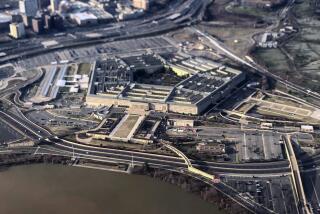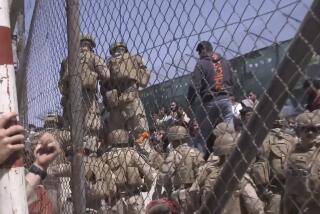U.S. fatalities in Afghanistan declining
- Share via
KABUL, Afghanistan — Over the last 25 days, something unusual has happened in Afghanistan: Not one U.S. service member has been killed. The lion’s share of the fighting — and dying — is now being done by Afghans.
The last American troop death, from injuries suffered in a December roadside bombing, occurred Jan. 20, marking the longest stretch without a fatality since 2008 and offering a glimmer of evidence that the United States’ 11-year war is in its twilight. Deaths among U.S. troops in Afghanistan last year reached a four-year low as commanders hailed a tipping point in a conflict that has claimed more than 2,100 American lives.
With President Obama planning to bring home half the remaining 66,000 troops by next February and the rest by the end of 2014, the shrinking American death toll has bolstered his administration’s contention that the Taliban-led insurgency is degraded and that Afghan forces are ready to take charge of their country’s security.
American forces continue to carry out ground operations and provide crucial air power, but U.S. and Afghan officials say Afghans now lead well over 80% of combat operations and control areas where more than three-quarters of the population resides. Experts cite other reasons for the reduced U.S. casualties, as well, including new measures to prevent insider attacks, the possibility that insurgents are curtailing attacks during the withdrawal and the usual reduction in fighting during the winter.
But it is also clear that the last American has not yet died in Afghanistan, and analysts caution that fewer fatalities doesn’t necessarily indicate that the U.S. and its allies are even winning.
Afghan soldiers and police now number nearly 350,000. Last year was the deadliest so far for the Afghan army, with 473 soldiers killed in the six months ending Jan. 19, according to Defense Ministry statistics. In the same period, 163 coalition soldiers were killed, including 127 Americans, according to icasualties.org, a website that tracks military deaths.
“It’s a function of numbers on the Afghans’ part and a growing capability and capacity that really has allowed them to shift to the forefront of operations,” said Marine Maj. Gen. Joseph L. Osterman, deputy chief of staff for joint operations at the U.S.-led international coalition in Kabul, the capital.
Insurgent attacks nationwide declined by more than a quarter in 2012, according to the Afghanistan NGO Safety Office, which advises humanitarian agencies on security trends. But U.S. commanders acknowledge that insurgents may be curtailing attacks in response to the drawdown of foreign troops. In 2010, when American forces reached their peak of 100,000, Taliban attacks surged along with the U.S. death toll.
“A lot of low-level insurgents … may have been motivated to fight foreign forces and now may be asking, ‘Why am I fighting this?’” Osterman said. “It’s where you may start to see a divide between the insurgents and their senior leadership.”
Experts say the gains may be short-lived because the U.S. drawdown is taking place in the absence of a credible peace process between the Afghan government and the Taliban, which retains strongholds in some rural areas and along the rugged eastern border with Pakistan.
The NGO Safety Office, in a report issued last month, said that insurgents still were responsible for nearly half of all the bombings, shootings, abductions and other security incidents nationwide in 2012, indicating that coalition forces hadn’t decisively tipped the conflict in their favor. The group concluded that the drop in insurgent activity “is a deliberate and reversible choice in response to the [NATO] withdrawal.”
Part of the reduction in American deaths, too, is the result of U.S. forces circumscribing their mission in response to the so-called insider attacks by Afghan security forces that killed 61 NATO personnel in 2012, the vast majority of them Americans. The U.S. military built separate compounds at bases they once shared with Afghan soldiers and police and enlisted “guardian angels,” armed troops who stand guard when American service members encounter Afghan allies.
With all this, experts say that fewer American deaths doesn’t mean that “this is what winning looks like,” as Marine Gen. John R. Allen, the former coalition commander, said in his farewell speech last week.
“The U.S. political climate is such that the administration has to show some sort of good news to justify [the troop exit], and that is dictating what is being shown in terms of progress, even if there isn’t any,” said Daoud Sultanzoy, a political analyst in Kabul and former independent member of the Afghan parliament.
Fighting usually slows in winter, when snow makes Afghanistan’s mountainous regions harder to navigate. But amid a relatively mild season this year, significant combat operations have continued in a sign that coalition forces are trying to press an offensive before the U.S. presence shrinks.
A coalition helicopter crashed last week in eastern Afghanistan, and although no deaths were reported, it highlighted the fact that North Atlantic Treaty Organization forces still provide the Afghan army with nearly all its air power.
U.S. troops also are carrying out ground operations in Taliban strongholds, exposing them to close-up combat. On Tuesday night, according to Afghan officials, a joint NATO-Afghan ground force came under fire from insurgents in a village in the eastern province of Kunar. The team called in a NATO airstrike that killed 10 civilians in addition to four Taliban commanders, the officials said.
Marine Gen. Joseph F. Dunford Jr., who succeeded Allen as coalition commander, met with President Hamid Karzai on Thursday to discuss the incident, but NATO officials declined to offer details or say whether any of its soldiers had been killed or wounded.
In their zeal to depart by 2014, some analysts say, U.S. officials are accepting the shortcomings of Afghan security forces. Many of the Afghan casualties are caused by accidents or poor equipment; attrition rates remain high; and almost no units can operate without U.S. or NATO support.
When Obama declared in his State of the Union message this week that “by the end of next year, our war in Afghanistan will be over,” some in Kabul noted bitterly that he only meant the U.S. war effort. Afghan forces, they said, would have to continue to fight.
“The past 12 years created a situation where the Afghan army and police were always sort of the auxiliary force,” Sultanzoy said. “Now they are the main force, and they have to adjust to this new role.”
Special correspondent Hashmat Baktash contributed to this report.
More to Read
Sign up for Essential California
The most important California stories and recommendations in your inbox every morning.
You may occasionally receive promotional content from the Los Angeles Times.











